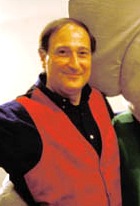This Fall marks the twentieth season of provocative programming in New York City brought to you by Interpretations. Founded and curated by baritone Thomas Buckner in 1989, Interpretations focuses on the relationship between contemporary composers from both jazz and classical backgrounds and their interpreters, whether the composers themselves or performers who specialize in new music. To celebrate, Jerry Bowles has invited the artists involved in this season’s concerts to blog about their Interpretations experiences. Our fourth concert this season, on 20 November, features composer-performers JB Floyd and Raphael Mostel at Roulette.
JB Floyd:
 My concert on the Interpretations Series on November 20th will mark the third time that I have presented my compositions on this prestigious series. These concerts have featured my works for flute and piano, vocal pieces for Thomas Buckner and the Yamaha Disklavier™ and keyboard works that combine the unique features of the Yamaha Disklavier™ as a concert piano and as a controller keyboard.
My concert on the Interpretations Series on November 20th will mark the third time that I have presented my compositions on this prestigious series. These concerts have featured my works for flute and piano, vocal pieces for Thomas Buckner and the Yamaha Disklavier™ and keyboard works that combine the unique features of the Yamaha Disklavier™ as a concert piano and as a controller keyboard.
Though my music is mostly notated there are usually opportunities for improvisation within each composition. Having worked on many occasions with Thomas Buckner I am particularly looking forward to our work together on a new piece of mine, In Crossing The Busy Street for baritone voice and Yamaha Disklavier™. The poem is by Daniel Abdal-Hayy Moore a poet whose works inspire musical representation.
Other compositions are for the Yamaha Disklavier™ and will be performed by my talented protégé, Liana Pailodze who is an Artist Diploma candidate at the Frost School of Music at the University of Miami. It is an honor to be included on this celebrated series that is celebrating its 20th Anniversary.
Raphael Mostel:
 Thirteen Ways of Looking at a Black Bela
Thirteen Ways of Looking at a Black Bela
I am haunted by Bela Bartok. He composed certain musical ideas which pursue me, and unbidden keep coming back to mind. My Thirteen Ways of Looking at a Black Bela is an attempt to exorcise this musical “possession” using one particularly searing turn from Bartok’s Piano Sonata. I’ve enlisted help from John Cage, Morton Feldman, Leonard Bernstein, Gyorgy Kurtag and many others. Wallace Stevens’ poem seemed to bless this exorcism. My apologies to triskadecaphobes.
A Letter to Benoit Mandelbrot, or, Authenticity
I’d written to Benoit Mandelbrot, the father of fractal geometry, asking if he’d never wondered why — since visual representations of fractals are so beautiful — the supposed musical representations of fractals are not? I offered to explicate mathematically. He wrote back inviting elaboration, which I did. But my explanation, he said, “mystified” him. My Letter to Benoit Mandelbrot is a further meditation on music, self-similarity and cheating.
